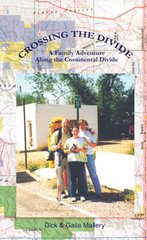
In 2005, Andrew Skurka became the first person to hike the entire Sea-to-Sea Route, a nearly 7,800-mile trek from Cape Gaspe, Quebec, to the Olympic Peninsula that took him 339 days to complete. The following summer he cooked up his next big trip: a 6,875-mile journey through the American West linking the Pacific Crest Trail, Pacific Northwest Trail, Continental Divide Trail, Grand Enchantment Trail, and Arizona Trail, plus a trail-less segment through the Sonoran and Mojave deserts. Demetri Coupounas, president of GoLite, Skurka’s lead sponsor, later dubbed this hike the Great Western Loop. Skurka finished the Great Western Loop on November 3, 2007, after 208 days of hiking.
Here he talks about the most indispensible gear he used (it involves a can of cat food), how he put back 11 energy bars a day, and where he’s off to next.
Outside Online: How did you prepare for the hike? Physically, the best way to prepare for a long-distance hike is to go hiking. But prior to this hike I was still working and was very busy planning. So instead I ran in the foothills of Boulder for one hour on weekdays and two or three hours on weekends. I also commuted 35 minutes each way to work and lifted weights five days a week.
Mentally, I had to recognize that the Great Western Loop would be the most difficult thing I had ever done—my most intense, sustained effort—but that the experience would be worthwhile, partly because of this adversity.
You have also talked a lot about another motivating factor for the hike: seeking out the effects of global warming on the West first-hand. Were you successful in this respect?Because climate change is a long-term trend, it was unreasonable to think that every predicted effect of global warming would be observable during my hike. The only effect I could really count on was the much smaller, or all-together disappearance of, glaciers in the Cascades and northern Rockies.
But many other effects were observed too, like prolonged drought in the Southwest, significantly reduced snowpack in the Sierra Nevada, a record-breaking heat wave in the Northwest, an unusually long and intense fire season in Montana, and a catastrophic outbreak of mountain pine beetles in Colorado. While each of these events may be attributable to something else—La Niña, or poor forest management, for example—it is perhaps not a mere coincidence, and if nothing else provides a glimpse of the West’s future.
You hiked some 33 miles a day. Can the average Joe, in reasonably good shape, also conquer the Great Western Loop?A more accessible approach might be to hike it over two years, figuring about 150 or 180 days a year, at 20 miles per day, which is a completely doable pace for someone who is reasonably fit, who carries lightweight gear, and who can resist frequent temptations to spend lots of time in civilization.
What was your favorite section of the hike?The best section was through Colorado, from the Indian Peaks Wilderness to the South San Juan Wilderness, about 500 miles. No other state can boast as much consistently world-class trail and scenery as Colorado—in the San Juan’s there is so much alpine walking that I actually was looking forward to getting back in the timber. Also, the elk were in the peak of their rutting season, the aspens were glowing gold, and the trails were essentially empty.
Did you have any major setbacks along the way?In August, a few weeks after I had reached the halfway point, my grandmother passed away unexpectedly, and I lost five days to travel and to the wake and funeral. I was on pace when it happened, and I was able to make up two of the lost days in Montana, so I managed okay. The bigger issue, though, was that I was emotionally numb for two weeks.
Was being on the trail therapeutic during that grief? Or did it make it worse?The trail made it both easier and more difficult. After I was given the news, I had another 70 miles to hike until I could hitchhike to the airport. They were miserable miles. I really just wanted to be with my family, not hiking by myself. After I returned, the trail forced me to get my focus back earlier than I might have otherwise. The task at hand needed my attention.
What was the most valuable piece of gear you had with you?My pack usually weighed in at a mere 7.5 pounds (sans food, water, and fuel), and every piece of gear I carried was valuable to my survival, comfort, and/or enjoyment. But there were definitely a few standout items. My GoLite Jam2 backpack went the entire distance and looks no worse for it now, except a permanent odor. Another GoLite product was the Wisp windshirt, which I used almost daily to protect myself from wind, drizzle, snow, and bugs. My .3-oz alcohol stove, which I made from a Fancy Feast cat-food can, never broke or clogged, and it served up seven months of steaming hot dinners. My Komperdell trekking poles offered traction on sketchy surfaces, provided stability on technical terrain, and diverted stress and impact away from my leg joints and muscles. And in Arizona, I once used them to fight off a gang of aggressive javelinas.
We read that you ate an average of 11 energy/granola bars a day on the trail. Didn’t you get sick of them? Have you eaten one since?I ate more than 1,200 Balance Bars during my trip, plus 650 other energy bars, 250 candy bars, 600 ounces of Pringles, 600 ounces of deluxe mixed nuts, and more than 750 ounces of Hershey’s Special Dark chocolate. I ate essentially the same stuff everyday, but I never got tired of it—hunger is definitely the best seasoning. Since I’ve been off the trail, I’ve toned down my consumption of trail food, but not entirely since energy bars are convenient and nutritious, and since I have about a month’s supply of them still around.
What’s the first thing you ate after you got off the trail?On the ride back to Flagstaff from the Grand Canyon I had a half-dozen homemade chocolate-chip cookies, followed by a half-pound burger with fries and a few beers for dinner.
Now that you’re settled back in Boulder, what’s next?The next big trip will probably have to wait until 2009, just because of the time required to develop the idea and plan for it. Recently I’ve been scheduling slideshows, writing a book proposal, and figuring out where I’m going to hike in 2008. I’ll probably do a handful of shorter trips—the biggest, if it happens, will be in the Canadian Arctic.
Anything else you want to tell us?Yes, lots of things, but I’ll save them for a book.
--Kate O'Mara
Here he talks about the most indispensible gear he used (it involves a can of cat food), how he put back 11 energy bars a day, and where he’s off to next.
Outside Online: How did you prepare for the hike? Physically, the best way to prepare for a long-distance hike is to go hiking. But prior to this hike I was still working and was very busy planning. So instead I ran in the foothills of Boulder for one hour on weekdays and two or three hours on weekends. I also commuted 35 minutes each way to work and lifted weights five days a week.
Mentally, I had to recognize that the Great Western Loop would be the most difficult thing I had ever done—my most intense, sustained effort—but that the experience would be worthwhile, partly because of this adversity.
You have also talked a lot about another motivating factor for the hike: seeking out the effects of global warming on the West first-hand. Were you successful in this respect?Because climate change is a long-term trend, it was unreasonable to think that every predicted effect of global warming would be observable during my hike. The only effect I could really count on was the much smaller, or all-together disappearance of, glaciers in the Cascades and northern Rockies.
But many other effects were observed too, like prolonged drought in the Southwest, significantly reduced snowpack in the Sierra Nevada, a record-breaking heat wave in the Northwest, an unusually long and intense fire season in Montana, and a catastrophic outbreak of mountain pine beetles in Colorado. While each of these events may be attributable to something else—La Niña, or poor forest management, for example—it is perhaps not a mere coincidence, and if nothing else provides a glimpse of the West’s future.
You hiked some 33 miles a day. Can the average Joe, in reasonably good shape, also conquer the Great Western Loop?A more accessible approach might be to hike it over two years, figuring about 150 or 180 days a year, at 20 miles per day, which is a completely doable pace for someone who is reasonably fit, who carries lightweight gear, and who can resist frequent temptations to spend lots of time in civilization.
What was your favorite section of the hike?The best section was through Colorado, from the Indian Peaks Wilderness to the South San Juan Wilderness, about 500 miles. No other state can boast as much consistently world-class trail and scenery as Colorado—in the San Juan’s there is so much alpine walking that I actually was looking forward to getting back in the timber. Also, the elk were in the peak of their rutting season, the aspens were glowing gold, and the trails were essentially empty.
Did you have any major setbacks along the way?In August, a few weeks after I had reached the halfway point, my grandmother passed away unexpectedly, and I lost five days to travel and to the wake and funeral. I was on pace when it happened, and I was able to make up two of the lost days in Montana, so I managed okay. The bigger issue, though, was that I was emotionally numb for two weeks.
Was being on the trail therapeutic during that grief? Or did it make it worse?The trail made it both easier and more difficult. After I was given the news, I had another 70 miles to hike until I could hitchhike to the airport. They were miserable miles. I really just wanted to be with my family, not hiking by myself. After I returned, the trail forced me to get my focus back earlier than I might have otherwise. The task at hand needed my attention.
What was the most valuable piece of gear you had with you?My pack usually weighed in at a mere 7.5 pounds (sans food, water, and fuel), and every piece of gear I carried was valuable to my survival, comfort, and/or enjoyment. But there were definitely a few standout items. My GoLite Jam2 backpack went the entire distance and looks no worse for it now, except a permanent odor. Another GoLite product was the Wisp windshirt, which I used almost daily to protect myself from wind, drizzle, snow, and bugs. My .3-oz alcohol stove, which I made from a Fancy Feast cat-food can, never broke or clogged, and it served up seven months of steaming hot dinners. My Komperdell trekking poles offered traction on sketchy surfaces, provided stability on technical terrain, and diverted stress and impact away from my leg joints and muscles. And in Arizona, I once used them to fight off a gang of aggressive javelinas.
We read that you ate an average of 11 energy/granola bars a day on the trail. Didn’t you get sick of them? Have you eaten one since?I ate more than 1,200 Balance Bars during my trip, plus 650 other energy bars, 250 candy bars, 600 ounces of Pringles, 600 ounces of deluxe mixed nuts, and more than 750 ounces of Hershey’s Special Dark chocolate. I ate essentially the same stuff everyday, but I never got tired of it—hunger is definitely the best seasoning. Since I’ve been off the trail, I’ve toned down my consumption of trail food, but not entirely since energy bars are convenient and nutritious, and since I have about a month’s supply of them still around.
What’s the first thing you ate after you got off the trail?On the ride back to Flagstaff from the Grand Canyon I had a half-dozen homemade chocolate-chip cookies, followed by a half-pound burger with fries and a few beers for dinner.
Now that you’re settled back in Boulder, what’s next?The next big trip will probably have to wait until 2009, just because of the time required to develop the idea and plan for it. Recently I’ve been scheduling slideshows, writing a book proposal, and figuring out where I’m going to hike in 2008. I’ll probably do a handful of shorter trips—the biggest, if it happens, will be in the Canadian Arctic.
Anything else you want to tell us?Yes, lots of things, but I’ll save them for a book.
--Kate O'Mara












No comments:
Post a Comment